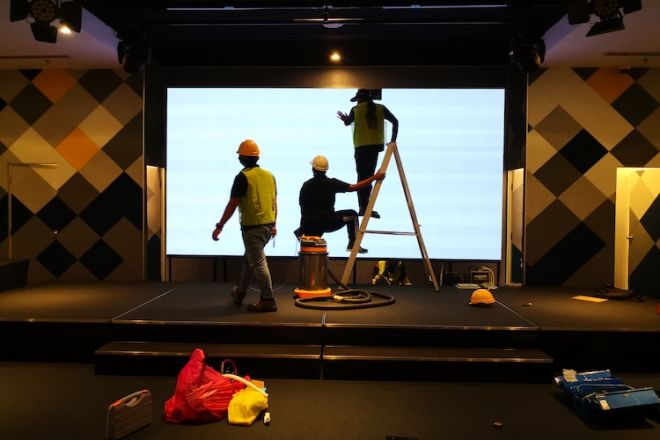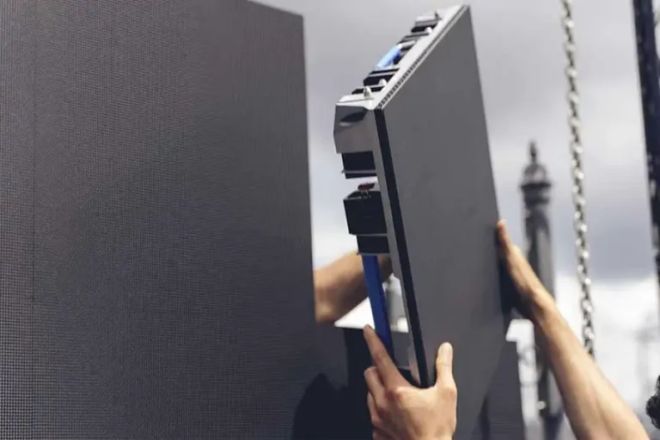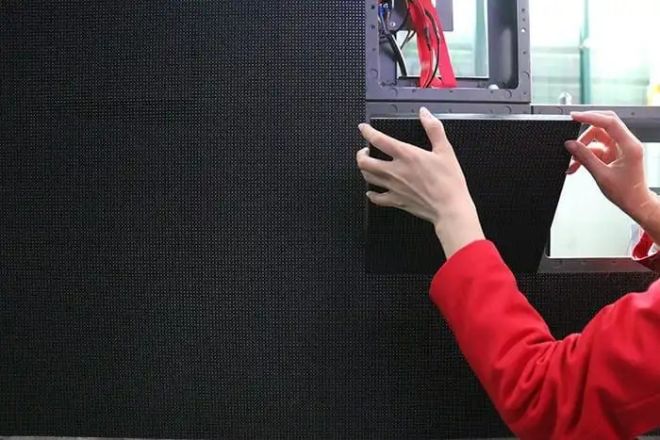Introduction

In the digital age, LED displays have become an indispensable and important display tool for all walks of life with their excellent display effects, flexible application scenarios, and powerful information dissemination capabilities.
From outdoor billboards in bustling cities to live broadcasts of indoor exhibitions, performances, and sports events, LED displays are everywhere, enriching our visual experience and promoting the efficient dissemination of information.
However, facing the dazzling array of LED display products and numerous installers on the market, how to accurately choose a professional and reliable partner has become the focus of many demand parties.
1. What do you need to prepare before looking for an installer?
1). Understand the display installation market.
There are many types of LED display screens on the market, and the prices vary depending on factors such as brand, model, specifications, and installation complexity, including the size, resolution, brightness, installation method (such as wall-mounted, hanging, embedded, etc.), installation environment (indoor/outdoor), and the complexity of the installation project. Therefore, it is difficult to give a unified price standard.
Generally speaking, the installation price of LED display screens can range from a few thousand yuan to hundreds of thousands of yuan. For small indoor display screens, the installation price may be more affordable.
For large outdoor high-definition display screens, due to their large size, high technical requirements, and complex installation environment, the installation price will also increase accordingly.
In order to obtain a relatively accurate budget range, you need to understand the installation price of the mainstream LED display screens on the current market in advance.
This can be achieved in a variety of ways, such as consulting industry reports, consulting professionals, participating in industry exhibitions, or online searches.
When collecting information, pay attention to the price differences of display screens in different application scenarios (such as commercial advertising, stadiums, stage performances, etc.) to better match your project needs.
2). Prepare relevant documents and drawings.
If possible, provide detailed drawings or photos of the installation location so that the installer can better understand the site conditions. If you have specific design requirements or creative ideas, you can prepare some sketches or design drawings to discuss with the installer. For example, the following:
- Installation location and environment:
Describe the installation location of the LED display in detail, including whether it is indoors or outdoors and whether there are specific installation structures such as walls, ceilings, or light poles.
For outdoor installations, special attention should be paid to the impact of environmental factors, such as wind, rain, temperature, etc., on the installation, and additional protective measures may be required.
- Structural requirements:
Determine the type and specifications of the required installation structure (such as brackets, suspension systems, etc.) based on the weight and size of the display. Ensure that the installation structure is stable and reliable and can withstand the weight of the display and vibration during operation.
3). Make a list of key questions.
In the process of selecting an LED display installer, it is crucial to develop a detailed and targeted list of questions. This will not only help you fully understand the installer’s capabilities and service level but also ensure smooth communication between the two parties during the project execution, reducing unnecessary misunderstandings and disputes.
Here is a list of key questions you can ask the installer regarding technical strength, after-sales service, construction process, and price details:
3.1). Technical strength
Technical team composition: Please introduce the size of your company’s technical team, professional background, and core technical personnel.
Industry experience: How many years of experience does your company have in the field of LED display installation? Can you share some representative success stories?
Technical certification and qualifications: Has your company obtained relevant technical certifications and qualification certificates? Can you provide supporting documents?
Technical innovation and R&D: Does your company focus on technological innovation and product development? What new technologies or products will be applied to the project?
3.2). After-sales service
After-sales service system: Please describe your company’s after-sales service system in detail, including service content, service process, and service standards.
Warranty period: How long is the warranty period for LED displays and installation projects? What does the warranty cover?
Maintenance response time: In the event of a failure, how long is your company’s maintenance response time? Is there a 24-hour emergency service?
2. What are the characteristics of a professional LED display installer?

Professional LED display screen installers usually have the following qualities, which are key factors to ensure the successful implementation and long-term stable operation of the project:
- Strong technical strength:
Professional installers have a skilled and experienced technical team that can cope with various complex installation environments and technical problems.
They are familiar with the latest technologies and product features of LED display screens and can provide customers with professional technical support and solutions.
- Rich industry experience:
Long-term industry accumulation has enabled professional installers to accumulate a large number of successful cases and valuable experience.
They can provide customized design and construction plans according to the specific needs of customers to ensure that the project achieves the expected results.
- Perfect after-sales service system:
Professional installers pay attention to after-sales service and have established a perfect after-sales service system. They provide comprehensive warranty services, including regular maintenance, troubleshooting, and rapid response, to ensure that customers have no worries during use.
At the same time, they also provide customer training and technical support to help customers better use and maintain LED display screens.
- Focus on construction quality and safety:
Professional installers are well aware of the importance of construction quality and safety, so they strictly abide by relevant standards and specifications during the construction process to ensure that the construction quality meets the requirements.
They pay attention to on-site management and safe operations and take a series of measures to prevent the occurrence of safety accidents.
Possess innovative spirit and R&D capabilities: With the continuous advancement of technology and the continuous changes in the market, professional installers need to have innovative spirit and R&D capabilities and constantly launch new technologies, new products, and new services to meet the diverse needs of customers.
They pay attention to industry dynamics and technological trends, actively introduce and, digest and absorb advanced technologies, and enhance their competitiveness.
- Good reputation and word of mouth:
Professional installers enjoy a good reputation and word of mouth in the market, and their service quality and professionalism have been widely recognized and praised by customers.
They focus on establishing long-term and stable cooperative relationships with customers, and win the trust and support of customers through high-quality services and professional technology.
3. Methods for finding suitable LED display screen installers
When looking for suitable LED display screen installers, we can adopt a variety of strategies to ensure that the final selected partner is both in line with project requirements and reliable. The following is a detailed expansion of two common methods:
1). Search online: There are many choices, but they may not be very reliable
1.1). Advantages:
Rich resources: The Internet provides us with a large number of information sources. Through search engines, industry websites, social media, and other channels, we can quickly find information about many LED display screen installers.
More convenient: Browsing and comparing the service content, prices, cases, etc., of different installers online, there is no need to run in person, saving a lot of time and energy.
High transparency: Many installers will disclose their qualification certificates, performance cases, customer reviews, and other information on the website, which will make it convenient for us to conduct preliminary screening and evaluation.
1.2). Precautions and response strategies:
- Identify the authenticity of information:
Due to the large amount of information on the Internet and its complexity, it is necessary to carefully identify the authenticity and accuracy of the information. You can verify the qualifications and reputation of the installer by checking the official website, third-party certification agencies, and other channels.
- Learn from multiple sources:
In addition to checking the installer’s own promotional materials, you can also use search engines to understand other users’ evaluations and feedback on the installer to obtain more comprehensive information.
- Field investigation:
After initially screening out several potential installers, it is recommended that they conduct a field investigation to understand their office environment, technical strength, construction cases, etc., so as to make a more accurate judgment.
2). Recommended by acquaintances: Few choices, but reliable
2.1). Advantages:
High trust: Recommended by acquaintances, it is usually based on the personal experience and good reputation of individuals or institutions, so it has a high degree of trust. This kind of recommendation can often reduce information asymmetry and moral risks.
Smooth communication: Due to the introduction and recommendation of acquaintances, communication with the installer may be smoother and more efficient. Both parties are more likely to establish trust and cooperation.
After-sales service is guaranteed: If the installer enjoys a good reputation and word of mouth among acquaintances, then its after-sales service will usually be more guaranteed. When problems arise, it is easier to get timely and effective solutions.
2.2). Matters needing attention and coping strategies:
- Expand your network:
Although the range of choices recommended by acquaintances may be relatively limited, we can increase the recommendation channels by expanding our own network. For example, participate in industry activities, join relevant communities, etc., and establish connections with more people.
- Actively ask for details:
When accepting recommendations from acquaintances, we should not only listen to the other party’s overall evaluation but also actively ask for specific details and cases. This helps us to have a more comprehensive understanding of the installer’s capabilities and service level.
- Maintain objective judgment:
Although acquaintance recommendations have a high degree of trust, we still need to maintain objective judgment. Before making a choice, you can make a comprehensive consideration based on your own needs and budget to ensure that the final installer you choose is the most suitable for your project.
4. Matters worth noting

1). Qualification certificate
When looking for an LED display screen installer, it is a crucial step to verify whether it has relevant qualification certificates and certifications.
These certificates and certifications are not only a reflection of the installer’s professional ability but also an important guarantee of its credibility and reliability. The following are several aspects of the detailed analysis of the qualification certificate:
2). Construction qualification
- Importance:
Construction qualification is an important basis for evaluating whether the installer can undertake a specific project. It is usually issued by the state or industry authorities, indicating that the installer has reached certain standards and requirements in terms of construction management, technical personnel, construction equipment, etc.
- Verification method:
The installer can be asked to provide a copy or scan of the construction qualification certificate and verify it through official channels (such as government websites, industry associations, etc.). At the same time, you can also ask the installer about past construction project cases to understand its construction capabilities and experience.
3). Product certification
- Importance:
Product certification is an important part of ensuring the quality of LED display screens. Through product certification, it can be confirmed that the display screen meets relevant standards and requirements in terms of performance, safety, environmental protection, etc. This helps to reduce project risks and improve the overall quality of the project.
- Verification method:
The installer can be asked to provide product certification certificates for LED display screens, such as international certifications such as CE, RoHS, UL, or domestic-related product certifications.
At the same time, you can also find out whether the installer cooperates with well-known brand manufacturers because products of well-known brands are often easier to obtain certification and market recognition.
4). Other relevant certificates
In addition to construction qualifications and product certifications, you can also pay attention to whether the installer has obtained other certificates and certifications related to LED display installation, such as quality management system certification (ISO 9001), environmental management system certification (ISO 14001), etc.
These certificates and certifications further prove the installer’s comprehensive strength in management, technology, and service.
In summary, verifying the installer’s qualification certificates and certifications is an important basis for evaluating its professional ability and credibility. By carefully checking and verifying these certificates and certifications, you can reduce project risks and increase the success rate and satisfaction of the project.
5). Communication and Collaboration
During the entire LED display installation project, maintaining good communication and collaboration with the installer is the key to ensuring the smooth progress of the project. The following are several aspects of detailed analysis of communication and collaboration:
- Clear communication channels:
At the beginning of the project, the communication channels and methods should be clarified with the installer, including telephone, email, instant messaging tools, etc. Ensure that both parties can keep in touch at any time and convey project information and requirements in a timely manner.
- Regular communication meetings:
Arrange regular project communication meetings to discuss project progress, existing problems, and solutions with the installer. This helps to identify problems in time and take measures to solve them, avoiding the accumulation of problems that lead to project delays or failures.
- Timely feedback and adjustment:
During the project execution process, if you encounter problems or need to adjust the plan, you should communicate with the installer in time and reach a consensus. Both parties should work together to find the best solution to ensure that the project can proceed smoothly according to the established plan.
- Establish trust and cooperation:
Communication and collaboration are not only a process of information transmission and problem-solving, but also a process of establishing trust and cooperation. Both parties should respect, understand and support each other and face the challenges and difficulties in the project together. Through good communication and collaboration, we can enhance mutual understanding and trust and lay a solid foundation for future cooperation.
Conclusion
In summary, choosing a suitable LED display screen installer is the key to ensuring the success of the project. In this process, we need to clarify our own needs, conduct in-depth market research, fully communicate and evaluate with the candidate companies, and finally make wise decisions based on comprehensive considerations.
At the same time, we should also pay attention to the details of the contract, communication, and coordination during the execution process, and subsequent maintenance and care to ensure that the display screen can operate stably for a long time and continue to bring us value.
Finally, if you want to know more about LED display screens, please get in touch with us.
